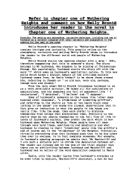‘Wuthering Heights’ is structured around two love stories. The central relationship between Cathy and Heathcliff, in the first part of the novel, is not one that is conventional, but destructive. The passion they have for one another has been built up from their childhood. Heathcliff’s love of Cathy eventually corrupts into a lust for revenge after she marries Edgar Linton and especially after her death. The second generation, being the younger Catherine and Hareton, echo the relationship of Cathy and Heathcliff, the first generation. Catherine can often be seen as revising her mother’s story.
Lockwood enters Wuthering Heights as an outsider and remains so for most of the novel. As the reader, there are aspects of us also feeling like an outsider, coming into a world, which is uncivilised and hostile. Through Lockwood’s narrative, we find out what his first opinions are of the characters, therefore it influences our own. At the beginning, Lockwood is intrigued, especially by Heathcliff. This also immediately makes us want to know more about Heathcliff. Lockwood says
‘I felt interested in a man who seemed more exaggeratedly
reserved than myself.’
Emily Brontë uses Lockwood’s narrative as a key to tell us about Heathcliff. Lockwood symbolises a civilised society and appears to be intelligent and well educated. His detailed descriptions and observation in Wuthering Heights comment on situation and character and the changes that take place. On Lockwood’s first visit to Wuthering Heights, he comments on the chained gate and the ‘wildness of crumbling griffins’. Towards the end of the novel, however, when Lockwood returns to find that Heathcliff has died, he notices that
‘Both doors and lattices were open’.
Nelly Dean is an important narrator, as she brings us closer to the action in Wuthering Heights. She has experienced first hand what life is like in Wuthering Heights, therefore allowing us to get a different perspective of the character of Heathcliff. A major contrast between Lockwood and Nelly Dean is that, to some extent, she is a character within her own narrative and is telling the past from the present. As Nelly Dean is the housekeeper, the different relationships within the novel are exposed to us. The sympathies that she has, especially for Heathcliff, then influence us to feel the same. Nelly appears to be a reliable narrator but not always objective. She has her own opinions, which can sometimes be biased.
Another technique that Emily Bronte uses for the narrative is Isabella’s letter. From this, we find out her feelings and again, another perspective of Heathcliff’s character. With all the different narratives and different opinions of Heathcliff, it is difficult for the reader to find the true Heathcliff and what he is really like.
It is debatable whether Zillah, the other housekeeper at Wuthering Heights, is a narrator in herself. When Nelly lives at Thrushcross Grange, Zillah is responsible for the second generation Cathy. Nelly must rely upon the reports of Zillah for the news of young Cathy’s life. From this, we see Emily Bronte’s calculating technique for us to not always know what goes on at Wuthering heights.
Many critics have questioned why Emily Bronte has created such a complex narrative. One reason may be to make Wuthering Heights a more believable and realistic place.







